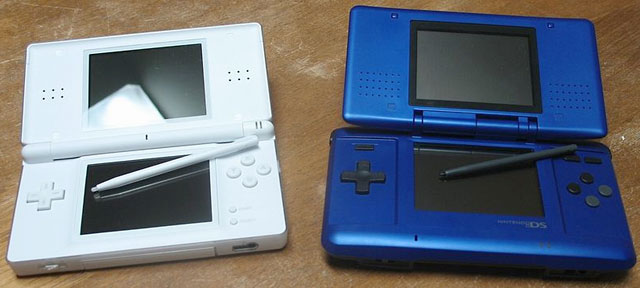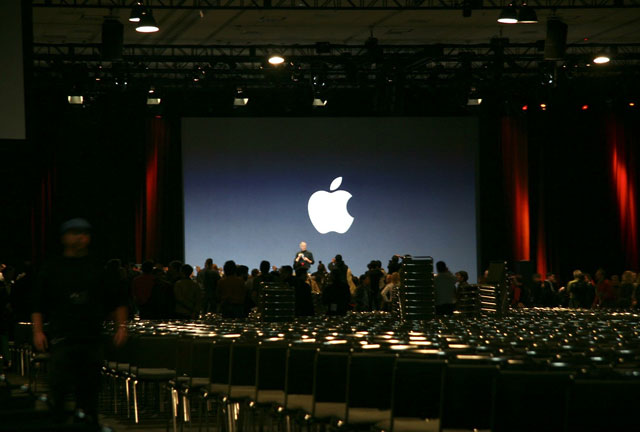Welcome to the first Reader Roundup for the “Leo and Mac” column on Low End Mac, where we take a look at a sampling of reactions shared by readers on articles I’ve written.
All of the comments that follow come from ones made by members of the Low End Mac group on Facebook in a post with a link to my previous article. Every person quoted has given permission for their comments to be shared here.

The article in question in this roundup is my opinion piece from April 27, Looking Ahead: Apple Has Its Cards Lined Up and its Poker Face Showing, in which I explored where the Cupertino-based tech company might be headed with its hardware and software.
My gamble was that Apple would be releasing a hybrid touchscreen Mac notebook computer running iOS — because of news that the Cupertino-based company plans to move to its own ARM processors in 2020 — bringing forth the next era of Apple computing.
The main point of discussion by readers revolved around the hybrid touchscreen Mac notebook computer, and here’s what some people had to say on the topic.
First up is our own Dan Knight, publisher of Low End Mac, who says,
“I can’t see Apple going ARM-only on the Mac Pro, MacBook Pro, and iMac Pro in the near future. I would look for an Intel-ARM hybrid to provide the touchscreen support iOS apps require. Mac Pro and Mac mini would probably require a special touch display from Apple with the ARM build into it, letting current Intel models add iOS support with a new touchscreen.
“For the consumer iMac and MacBook, ARM alone may be viable within a year or two, but I suspect that emulation for Intel-only apps would be an issue. (Then again, Rosetta).”
Rosetta, for those who may not be familiar with it, was a software application apple built into Mac OS X beginning with OS X 10.4 Tiger and ended with OS X 10.6 Snow Leopard. The software, which ran unseen in the background, allowed applications designed for the PowerPC architecture to run seamlessly on Intel-based Macs when Apple made the switch from PowerPC processors to Intel in 2006. While classified as emulation software, Apple’s official support page for Rosetta states that “there’s no emulation” involved with its use.
Knight’s comparison of the reported move by Apple to ARM-based processors and emulating Intel-native software would mirror the way the transition from PowerPC to Intel processors occurred. In 2007, Steve Jobs began his Macworld Expo keynote address and said that, having used the same venue to announce the move to Intel processors the year before, a faster than expected “most smoothest and successful transition that we’ve ever seen” was attributed to the creation of a seamless version of OS X to Intel processors and – you guessed it – Rosetta.
“Having fiddled with Android emulation on my MacBook and iMac, I can say that a touchscreen would make it work far better than using a mouse,” says Knight. “I fully expect it to happen someday, but I think it will start on the low end with MacBooks and iMacs since they have built-in displays and can most easily use a touchscreen display.”
Ed Eubanks, 42, of the Memphis, TN area says,
“I see a day coming where basically everything is a potential screen, and also a potential input device.
“I don’t think a touch ‘screen’ alone can replace the mouse/trackpad (it’s one of the main reasons why I still use a laptop and external keyboard/mouse for 95% of my actual work, instead of an iPad Pro), but when they finally get touchscreens that function as well as a membrane-style keyboard, laptops will basically be just two screens that fold together.”
That prediction isn’t entirely off nor far off either. Back in March, as reported by Wired UK, an Apple patent for a touchscreen keyboard for a notebook computer could bring forth a dual-screen MacBook in the very near future.
While not the same as the fabled hybrid touchscreen MacBook, which would still have a physical keyboard and trackpad, the patent and prospect is exciting to think about just the same!
“When that time comes (and I really do believe it’s a question of when (not if) then there will be huge advantages for stuff like graphic design,” says Eubanks. “Shift the editing area down to the lower screen and work on it like you would paper, but still keep your palettes and menus in the upper screen (or drag some down to the lower screen as well).”

Nintendo DS Lite and the Nintendo DS. This work is licensed under the Creative CommonsAttribution-ShareAlike 3.0 License.
Just imagine a super-sized version of the Nintendo DS handheld gaming console released back in 2004. The dual-screen device, hence the “DS” in its name, has a viewing screen on the top half and a touchscreen on the lower half for special controls specifically adapted and designed for the current game being played.
Having owned one myself, it was truly innovative and almost ahead of its time considering the early titles were almost gimmicky and the touchscreen portion was sort of a distraction to the action taking place on the main screen. The games that were more appealing, in my opinion, were those that took advantage of the dual screen nature of the device by allowing the primary character in the game to move about freely between both screens.
Eubanks elaborates, “The adaptable nature of the touch bar is a hint toward this; how great would it be for Photoshop, InDesign, etc.—or even word processing tools, social media, browsers—to have their own customized keyboards?”

Steve Jobs poses for the cameras with the iPhone in hand at the end of his Keynote address at the Macworld Expo in San Francisco on January 9, 2007, in the Moscone Center West. (Photo: Joe Leo / PowerBook Central)
It was Jobs himself who famously said also in 2007 when introducing the iPhone at the Macworld Expo, “Why do we need a revolutionary interface? … here’s four smartphones … And what’s wrong with their user interfaces? … They all have these keyboards that are there whether you need them or not to be there.”
“And they all have these control buttons that are fixed in plastic and are the same for every application. Well, every application wants a slightly different user interface, a slightly optimized set of buttons for it,” continued Jobs. “It doesn’t work because the buttons and the controls can’t change. They can’t change for each application.”
“How do you solve this?” he asked rhetorically and answered, “What we’re gonna do is get rid of all these buttons and just make a giant screen. … We’re gonna touch this with our fingers. And we have invented a new technology called multi-touch which is phenomenal!”
Of course, Jobs would seemingly contradict himself three years later when introducing the iPad. For those who don’t know what I’m referring to, read on!
“Touch has its place but not for content creation,” argues Chris Kurowicki, 31, of Portland, OR. “Take the iPad, for example. Fantastic touch interface. I was sold when the iPad 2 came out. I bought one while I was in grad school. Everyone assured me I could do everything with this device that I could with a laptop.”
“I gave it a real go. After a week of using just that I bought a Bluetooth keyboard because it was so frustrating trying to type up anything of decent length. I’m sitting there in the library, with my iPad docked in a keyboard and I thought…what the heck am I doing? This is now a slightly inconvenient laptop that lacks a mouse. I sold it and went back to my MacBook Air and was happily on my way.”
For me, my iPad mini 4 has a Zagg keyboard folio case permanently attached to it, and I am able to use it like a regular notebook computer. In fact, it has replaced my 11″ MacBook Air (and my two other Macs) and has become my primary computer.
I have mentioned in the past that I am visually impaired and totally blind; I use the assistance of VoiceOver, built-in screen reader software that Apple provides for free with its two operating systems. I have found it much easier to navigate things in iOS with VoiceOver than it is to do so on Mac OS because of the touch-based interface compared to Mac OS, where you navigate with VoiceOver using the arrow keys and other combinations of keys on the keyboard. The iOS interface is much more intuitive and user-friendly. And if I choose, I am also able to navigate all the elements on the screen in iOS by simply using the arrow keys on the keyboard so that I don’t have to touch the screen. But touching the screen is still far easier than solely using a physical keyboard on Mac OS because you have the options for special commands and options in iOS by touching, swiping, or using the rotor which you can’t do in Mac OS.
That’s the big reason I am hoping for a hybrid touchscreen Mac desktop or notebook computer! And bringing Mac OS into the user experience by creating either a hybrid or unified operating system with iOS is what would set everything apart. Because I technically already have a touchscreen Mac notebook computer running iOS by simply having added a keyboard case to my iPad mini 4.
“Humans function better with tactile input. Touch screens save space but I’d argue all day that they are and always will be inferior to physical human interfaces,” says Kurowicki.
Chris Kurowicki is an information security and compliance analyst in the healthcare industry and has been reading Low End Mac since 2010.
Eubanks, replying to Kurowicki’s comment, disagrees. “I’m told that [the iPhone X] doesn’t have a physical home button, but the ‘haptic’ nature of it gives a tactile experience that is indistinguishable from previous iPhones.”
In a recent visit to the Apple Store, I wanted to test drive an iPhone X because I had never touched or held one in my hands since it was released. On my own iPhone SE and on all other iPhones that have a physical home button, in order to bring up the app switcher, you double tap the home button to switch between all your open apps. I was curious how this function would work on an iPhone X, so I asked an employee to show me how it was done without a physical home button present. It required a special swipe from the bottom of the screen and a tactile response ensued from the vibration mechanism indicating that the app switcher had been activated. It was interesting to say the least!
“I agree that it’s still a ways off, probably not for another couple of years at least,” says Eubanks. “Meanwhile the trackpads on MacBooks keep getting bigger and soon may as well occupy the whole bottom half of the base of the laptop. I bet we see larger and more versatile touchpad along the way too, and more adoption of them by developers. It will be a gradual transition until that point when it’s time to replace the hardware keyboard with a screen.”
“Remember how much BlackBerry users pined away for their hardware keyboard after the iPhone first came out? But now hardly anyone even talks about that, let alone still uses one — because we all got used to the screen-based keyboard for texting, mobile input, etc.”
That bottom 40, the term Jobs gave the physical keyboard area of “the usual suspects,” which he referred to the smartphones as when he unveiled the iPhone.
Ed Eubanks is a writer, editor, designer, and pastor who has been a reader of Low End Mac since 2003. He was also a writer for Low End Mac from 2004-08.
Ryan Turner, 42, of Cardiff, Wales in the UK says, “I doubt they will go for a touchscreen. I remember Jobs introducing the Magic Trackpad. He said they tried and tried with touch screens and it was always awkward and your arms got tired. It’s just not a good input device for a laptop.”
Actually, to be exact, Jobs said at that 2010 Apple event,
“We’ve done tons of user testing on this and it turns out it doesn’t work.
“Touch surfaces don’t want to be vertical. It gives great demo but after a short period of time you start to fatigue and after an extended period of time your arm wants to fall off. It doesn’t work, it’s ergonomically terrible!”
Maybe for a desktop computer, but with a notebook computer that’s positioned closer to the user? I’d beg to differ as someone who uses an iPad mini 4 attached to a keyboard folio case as his main computing device on a daily basis.
“It’s like that scene in Minority Report where he is waving his arms around manipulating the screen,” adds Turner, referring to the 2002 film starring actor Tom Cruise. “Lovely for 5 mins. Can you imagine doing that all day!”
Ryan Turner is the director of Studio T, a computer numerical control (CNC) and laser cutting company and has been a member of the Low End Mac group on Facebook for a little over a year.
We end this edition of the Reader Roundup with the sole person who practically agreed 100% with my prognostication and coincidentally is a resident of the San Francisco Bay Area as well.
Jerry Cole, 47, of Fremont, CA says, “I actually believe they will eventually go ARM, add touch input but not eliminate mouse/keyboard and likely go to some hybrid Mac/iOS.”
Cole adds, after asking him on Facebook Messenger to speak further on the subject, “I don’t know what else to say. I’m not a tech professional or anything just a user since the [Apple] IIe days. I have seen the coming and going of the II series, 680×0, PPC, etc.”
To clarify, Cole is referring to the Apple II & IIe computers, the 680×0 a Motorola processor, and PPC being short for the PowerPC processor.
“it makes sense in light of Apples past and more recent history,” says Cole. “I’m encouraged that Tim Cook has recently claimed that Mac users don’t want a full merger of the OSs but I do see an eventual overlap of compatibility and the streamlining of the CPUs to promote easier development and get away from a dependency on Intel.”
Almost my thoughts exactly. Must be a Bay Area thing?
Jerry Cole is a 35+ year Apple enthusiast who is in the nursing profession and has been a Low End Mac reader for a few years now.
And that about wraps it up for this first edition of the “Leo and Mac” Reader Roundup. We’ll bring you more reader reactions on my articles as they become available.
Want to join the discussion? You have options. Simply leave a reply at the end of my articles, become a member of our user group on Facebook, or contact me directly via email at macntechdude1701e@gmail.com. I’d love to hear your thoughts and feedback!
keywords: #leoandmac

